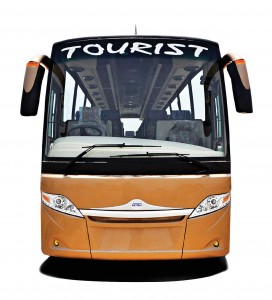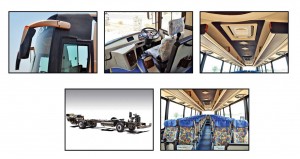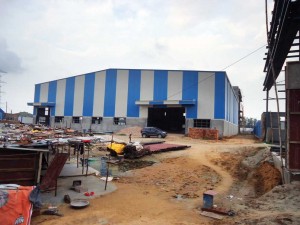Delhi-based Guru Ram Dass Body Builders is expanding its manufacturing capacity with a view of increasing its market share.
Story by: Anirudh Raheja
With the Bus Code a reality, Guru Ram Dass Body Builders is gearing up to keep up with the times. It is expanding its infrastructure with a hope that the organised market for buses will rise sharply. Established in 1982, the company has been building bus bodies of various types. It has been catering to bus fleet operators in many north Indian states and regions of the country. Part of a automobile body structure market that was largely unorganised for long, and was looked upon as an extension of the massive SME sector, the implementation of Bus Code has brought about a disruptive change. Mayank Kukreja, CEO, Guru Ram Dass Body Builders, is however happy. He opines that the new (Bus Code AIS052) regulations will streamline the bus body building industry. “Bus body code will alter the customer demand as local bus body building will no longer be legal. This will not only benefit us, but also our customers. The entire system as well as the safety levels in the industry will increase,” he mentions. In order to cater to the ever demanding customer, Guru Ram Dass has developed 73 variants of bus prototypes with various combinations of components fitted in a typical bus. It claims to have already got clearance for them from the Automotive Research Association of India (ARAI) for a hassle-free customer experience. This, says Kukreja, will help them to serve the diverse needs of the customers.
Tough nut to crack
The Bus Code certification procedure is a tough nut to crack avers Kukreja. He claims that it has already cost his company approximately rupees one-crore, inclusive of the R&D and bus body building costs. “It is good to adhere to the rules rather than to bypass them,” he states. He draws attention to the fact, that every bus made is subject to approval, which essentially translates into each bus being routed through approved certification agencies who would hold the right to alter or dismantle the bus body presented to them for certification and approval. Explains Kukreja, “One will be able to procure buses made from local workmen. However, during approval, the government will ask for the source of manufacture, which would ultimately be routed through approved bus body builders. Confident that the customer will not go to an unapproved bus body builder once he faces a hiccup, Kukreja mentions that except the paint every part fitted in a bus has to be as per the ARAI prescribed standards. Any deviation would mean additional procedures which would extend the time of approval. It could take up to a month more. It will also involve additional costs. “The paint code requires that there should be no corrosion for one year after painting; there should be no oil sagging, and the paint should not affect the bus body adversely,” Kukreja informs.
Capacity expansion
Anticipating a sharp rise in demand as the bus body building industry organises itself, and streamlines its processes, Guru Ram Dass is investing nine-crore rupees for expansion. It is doing so at its new facility at Bahalgarh, Sonipat. The company, according to Kukreja, has already pumped seven-crore rupees. A large chunk of the investment has gone into the procurement of 15 new machines. These include a tube cutting lunatic CNC machine, aluminium section cutting machine, hydraulic and pneumatic tube bending machine, reciprocating saw for cutting heavy channels, hydraulic power press for making dies, and for making lower panels seamlessly in order to achieve a high level of accuracy. The company is also aiming at creating a fixture system to improve the overall quality of the bus. “With the new assembly system, the work procedure will be fixture dependent rather than be technician dependent. The number of stages in the work procedure will increase. Work will however get distributed among a larger force; will be streamlined, and will need less time for execution,” states Kukreja. Currently operating with a workforce of 250, Guru Ram Dass is working towards increasing the headcount to 350 once the new plant goes on stream. Work is expected to begin by the end of this year.
From its two plants at Nangloi, Delhi, Guru Ram Dass is rolling out one bus per day on an average. This will double once the new plant at Bahalgarh goes on stream. Among the various northern states and regions, it is Allahabad and Delhi NCR, which lead the race for buses according to Kukreja. These two markets are instrumental in the growth of the company, and account for a changing customer profile as well. Mentions Kukreja, “The customer is very particular about the bus body. He often insists that work should be executed in front of him. He thinks that it presents him with an opportunity to alter the procedure if it is not going the way he thinks it should. This often makes it challenging for us. Even as we aim to serve the customer a high quality product, we make certain that we constantly communicate with him. Our location gives us the advantage of regularly conversing with the client.”
Building the bus body
It takes up to 45 days, including all the quality checks, to roll out a bus body. To manufacture one, it takes up to a month. The process includes the lining up of the bus chassis in the production line and educating the workforce on the design and other peculiarities pertaining to the respective bus body structure. Production, explains Kukreja, starts 10 days after the chassis rolls in. It takes three days for the workers to bind the structure. The galvanised iron sheet work takes another three days. The aluminium work pertaining to the side panels takes another two days. The interiors, including the fabrication of the dashboard, fascia, roof sheeting, panelling, window cut outs, air-con ducts, etc., takes the rest of the month. Avers Kukreja, “The bus body is bolted to the chassis using chassis clamps and U bolts. Different types of packing are used. The rest of the structure is welded.” The warranty of the chassis is 10 years, and the warranty of the structure is seven years. “After seven years, a new structure is built, which extends the warranty by another seven years. The overall life of the vehicle thus goes beyond 12 years.
Claims Kukreja that the aesthetics of a bus body made by them, and approved by ARAI, can be changed. Any change in the safety feature will however need an ARAI approval, and is by no means an easy task. “All the documentation has to be prepared again and sent in to ARAI for review. Once any changes in the safety features are approved by ARAI, only then do we have the option of making both or any of the two body types approved,” quips Kukreja. He highlights the flammability issue. “The entire bus body building industry has shifted to using FRP (Fibre Reinforcement Plastic) over ABS (Acrylonitrile Butadiene Styrene). ABS is a thermoplastic material and less costly. It is however flammable. FRP, at the other end, is costly but has a superior ability to mould, and is safe,” he mentions. Apart from the suppliers of FRP material, Guru Ram Dass is supported by close to 50 vendors. These range from the supply of seats, steel material, aluminium material, paint material, and vinyl. Up to 600 items are required in the construction of a bus body according to Kukreja.
Technological development
Technological developments is something that keeps the people at Guru Ram Dass on their toes. A lot of technological changes are underway in the industry, avers Kukreja. He even terms them as disruptive. The sleeper coaches that are emerging, states Kukreja, are out of the purview of the CMVR rules. “They get clearances easily at the RTO level. The day the CVMR guidelines are implemented, the market for sleeper coaches will be streamlined,” he adds. Like conventional inter-city buses, sleeper coaches also need permits. Most sleeper coaches operate at night. Their cost of permit per trip is therefore higher than a typical 2×2 seat coach that operates during the day. “Demand for 2×2 coaches and buses is higher. This will however change once the sleeper coaches get clearance from the agencies,” avers Kukreja. He states, “Even though rear engine buses offer higher comfort to both the driver and passengers, they have not seen a surge in demand. In a rear engine bus, the sound of the engine travels backwards. Carrying out repairs in a rear engine bus is easy. However, vehicle life is the same as that of a front engine bus. The seating capacity is the same. Price however is almost double than that of a front engine bus. This is perhaps the reason why rear engine bus demand has not gone up.” Guru Ram Dass has been offering an inter-city bus body built on a Ashok Leyland 12 m long rear engine bus chassis. Kukreja terms it as a unique blend of aesthetics and technical features. The bus comes with 45 2×2 reclining seats, electronic ORVMs, individual air-con vents and ample storage space.
Demand for bus bodies with provision for fitting an air-conditioner is on the rise. The decision of air-conditioner is done at the time of purchasing the chassis. However, a demand for providing the necessary plumbing and other bits, which will make it easy to fit an air-conditioner at a later date are growing according to Kukreja. “Technological updates are particularly asked for,” he adds. The demand for air suspension is also on the rise. A few years back only three to five buses were installed with pneumatic suspension. Today the number has shot up to 20. Comfort is assuming importance as the traveller is ready to pay. Demand for leaf springs is vanning, says Kukreja. The bus industry, he opines, is also progressing towards LED lighting systems. The market is flooding with Chinese LED lamps for buses even though they are not approved. They have to be approved by the ARAI. Concludes Kukreja, “Thankfully awareness in the bus industry is on the rise. Awareness for technology is on the rise. With the Bus Code implemented, and clarity of designs like sleeper coaches expected soon, the future looks promising. That is the reason why we are investing in a new manufacturing infrastructure.”























